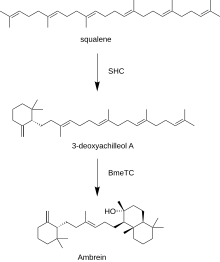Ambrein

| |
| Names | |
|---|---|
| IUPAC name
(1R,2R,4aS,8aS)-1-{(3E)-6-[(1S)-2,2-dimethyl-6-methylidenecyclohexyl]-4-methylhex-3-en-1-yl}-2,5,5,8a-tetramethyldecahydronaphthalen-2-ol
| |
| Other names
Ambrein
| |
| Identifiers | |
3D model (JSmol)
|
|
| ChEBI | |
| ChemSpider | |
| ECHA InfoCard | 100.006.784 |
PubChem CID
|
|
| UNII | |
CompTox Dashboard (EPA)
|
|
| |
| |
| Properties | |
| C30H52O | |
| Molar mass | 428.745 g·mol−1 |
Except where otherwise noted, data are given for materials in their standard state (at 25 °C [77 °F], 100 kPa).
| |
Ambrein is a triterpene alcohol that is the chief constituent of ambergris, a secretion from the digestive system of the sperm whale. It has been suggested as the possible active component producing the supposed aphrodisiac effects of ambergris.[1] Although ambrein itself is odorless, it serves as the biological precursor for aromatic derivatives such as ambroxan and is thought to possess fixative properties for other odorants.
It has been shown to act as an analgesic[2] and has been proven to increase sexual behavior in rats,[3] providing some support for its traditional aphrodisiac use.
Apart from its supposed aphrodisiac effects, ambrein has been shown to decrease spontaneous contractions of smooth muscles in rats, guinea pigs, and rabbits. It reduces these contractions by serving as an antagonist and interfering with Ca2+ ions from outside the cell.[4]
Discovery
[edit]In 1946, Ruzicka and Lardon "established that the fragrance of ambergris is based on the triterpene (named) ambrein".[5][6][7]
Biosynthesis
[edit]Ambrein is synthesized from the common triterpenoid precursor squalene. The squalene-hopene cyclase (SHC) catalyzes the cyclization of squalene into the monocyclic 3-deoxyachilleol A. Tetraprenyl-beta-curcumene synthase (BmeTC) converts 3-deoxyachilleol A into the tricyclic ambrein.[8]
References
[edit]
- ^ Sandroni P (October 2001). "Aphrodisiacs past and present: a historical review". Clinical Autonomic Research. 11 (5): 303–7. doi:10.1007/BF02332975. PMID 11758796. S2CID 40455528.
- ^ Taha SA (October 1992). "Studies on the mode of action of ambrein as a new antinociceptive compound". Japanese Journal of Pharmacology. 60 (2): 67–71. doi:10.1254/jjp.60.67. PMID 1479744.
- ^ Taha SA, Islam MW, Ageel AM (1995). "Effect of ambrein, a major constituent of ambergris, on masculine sexual behavior in rats". Archives Internationales de Pharmacodynamie et de Therapie. 329 (2): 283–94. PMID 8540767.
- ^ Taha SA, Raza M, El-Khawad IE (February 1998). "Effect of ambrein on smooth muscle responses to various agonists". Journal of Ethnopharmacology. 60 (1): 19–26. doi:10.1016/s0378-8741(97)00126-8. PMID 9533428.
- ^ Ruzicka, L.; Lardon, F. (1946). "Zur Kenntnis der Triterpene. (105. Mitteilung) Über das Ambreïn, einen Bestandteil des grauen Ambra". Helvetica Chimica Acta. 29 (4): 912–921. doi:10.1002/hlca.19460290414.
- ^ Prelog, Vladimir; Jeger, Oskar (1980). "Leopold Ruzicka (13 September 1887 – 26 September 1976)". Biogr. Mem. Fellows R. Soc. 26: 411–501. doi:10.1098/rsbm.1980.0013.
- ^ Hillier, Stephen G.; Lathe, Richard (2019). "Terpenes, hormones and life: Isoprene rule revisited". Journal of Endocrinology. 242 (2): R9 – R22. doi:10.1530/JOE-19-0084. PMID 31051473.
- ^ Di K, Qinggele C, Fanglong Z, Ting L, Wenyu L (February 2018). "Heterologous biosynthesis of triterpenoid ambrein in engineered Escherichia coli". Biotechnology Letters. 40 (2): 399–404. doi:10.1007/s10529-017-2483-2. ISSN 1573-6776. PMID 29204767. S2CID 3267910.
